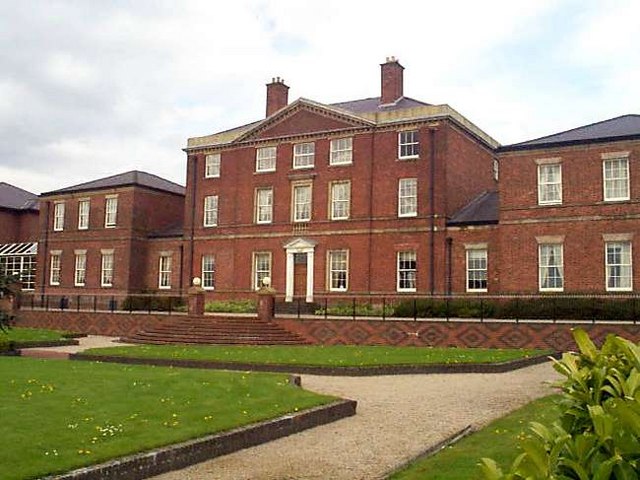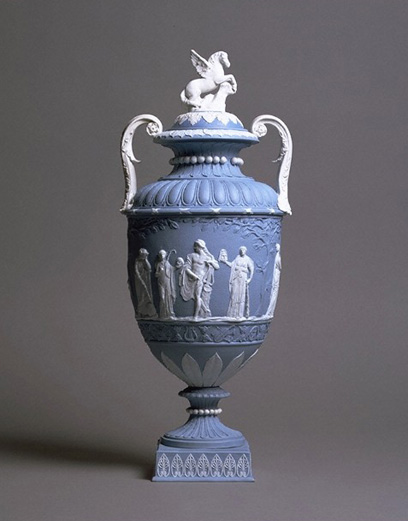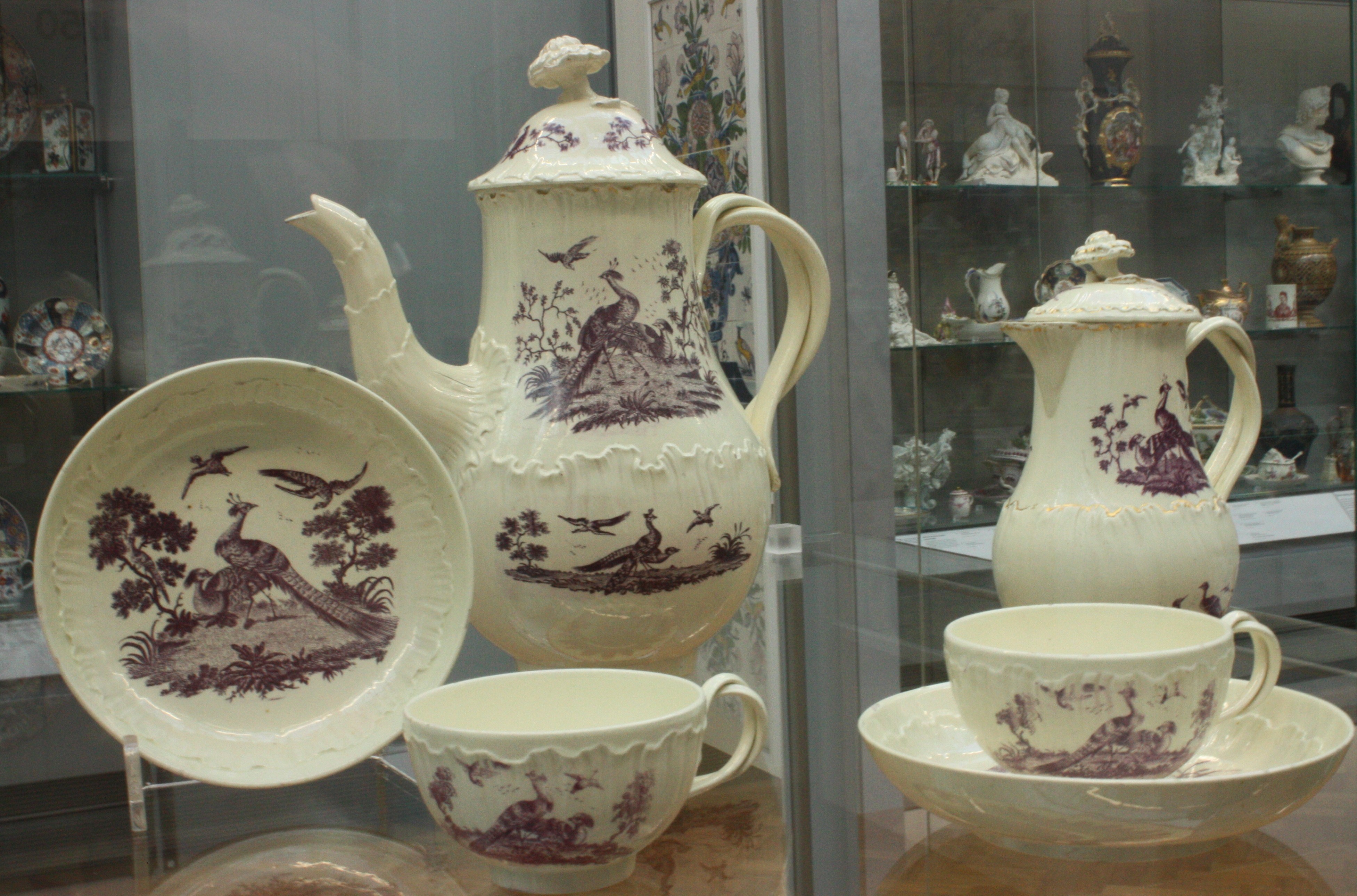|
Wedgwood
Wedgwood is an English fine china, porcelain and luxury accessories manufacturer that was founded on 1 May 1759 by the potter and entrepreneur Josiah Wedgwood and was first incorporated in 1895 as Josiah Wedgwood and Sons Ltd. It was rapidly successful and was soon one of the largest manufacturers of Staffordshire pottery, "a firm that has done more to spread the knowledge and enhance the reputation of British ceramic art than any other manufacturer", exporting across Europe as far as Russia, and to the Americas. It was especially successful at producing fine earthenware and stoneware that were accepted as equivalent in quality to porcelain (which Wedgwood only made later) but were considerably cheaper. Wedgwood is especially associated with the "dry-bodied" (unglazed) stoneware Jasperware in contrasting colours, and in particular that in "Wedgwood blue" and white, always much the most popular colours, though there are several others. Jasperware has been made continuously ... [...More Info...] [...Related Items...] OR: [Wikipedia] [Google] [Baidu] |
Wedgwood
Wedgwood is an English fine china, porcelain and luxury accessories manufacturer that was founded on 1 May 1759 by the potter and entrepreneur Josiah Wedgwood and was first incorporated in 1895 as Josiah Wedgwood and Sons Ltd. It was rapidly successful and was soon one of the largest manufacturers of Staffordshire pottery, "a firm that has done more to spread the knowledge and enhance the reputation of British ceramic art than any other manufacturer", exporting across Europe as far as Russia, and to the Americas. It was especially successful at producing fine earthenware and stoneware that were accepted as equivalent in quality to porcelain (which Wedgwood only made later) but were considerably cheaper. Wedgwood is especially associated with the "dry-bodied" (unglazed) stoneware Jasperware in contrasting colours, and in particular that in "Wedgwood blue" and white, always much the most popular colours, though there are several others. Jasperware has been made continuously ... [...More Info...] [...Related Items...] OR: [Wikipedia] [Google] [Baidu] |
Josiah Wedgwood
Josiah Wedgwood (12 July 1730 – 3 January 1795) was an English potter, entrepreneur and abolitionist. Founding the Wedgwood company in 1759, he developed improved pottery bodies by systematic experimentation, and was the leader in the industrialisation of the manufacture of European pottery. The renewed classical enthusiasms of the late 1760s and early 1770s were of major importance to his sales promotion. His expensive goods were in much demand from the upper classes, while he used emulation effects to market cheaper sets to the rest of society. Every new invention that Wedgwood produced – green glaze, creamware, black basalt, and jasperware – was quickly copied. Having once achieved efficiency in production, he obtained efficiencies in sales and distribution. His showrooms in London gave the public the chance to see his complete range of tableware. Wedgwood's company never made porcelain during his lifetime, but specialised in fine earthenwares and stonewares that had ... [...More Info...] [...Related Items...] OR: [Wikipedia] [Google] [Baidu] |
Jasperware
Jasperware, or jasper ware, is a type of pottery first developed by Josiah Wedgwood in the 1770s. Usually described as stoneware, it has an unglazed matte "biscuit" finish and is produced in a number of different colours, of which the most common and best known is a pale blue that has become known as Wedgwood Blue. Relief decorations in contrasting colours (typically in white but also in other colours) are characteristic of jasperware, giving a cameo effect. The reliefs are produced in moulds and applied to the ware as sprigs. After several years of experiments, Wedgwood began to sell jasperware in the late 1770s, at first as small objects, but from the 1780s adding large vases. It was extremely popular, and after a few years many other potters devised their own versions. Wedgwood continued to make it into the 21st century. The decoration was initially in the fashionable Neoclassical style, which was often used in the following centuries, but it could be made to suit oth ... [...More Info...] [...Related Items...] OR: [Wikipedia] [Google] [Baidu] |
Jasperware
Jasperware, or jasper ware, is a type of pottery first developed by Josiah Wedgwood in the 1770s. Usually described as stoneware, it has an unglazed matte "biscuit" finish and is produced in a number of different colours, of which the most common and best known is a pale blue that has become known as Wedgwood Blue. Relief decorations in contrasting colours (typically in white but also in other colours) are characteristic of jasperware, giving a cameo effect. The reliefs are produced in moulds and applied to the ware as sprigs. After several years of experiments, Wedgwood began to sell jasperware in the late 1770s, at first as small objects, but from the 1780s adding large vases. It was extremely popular, and after a few years many other potters devised their own versions. Wedgwood continued to make it into the 21st century. The decoration was initially in the fashionable Neoclassical style, which was often used in the following centuries, but it could be made to suit oth ... [...More Info...] [...Related Items...] OR: [Wikipedia] [Google] [Baidu] |
Thomas Whieldon
Thomas Whieldon (September 1719 in Penkhull, Stoke-on-Trent – March 1795) was a significant English potter who played a leading role in the development of Staffordshire pottery. The attribution of actual pieces to his factory has long been uncertain, and terms such as "Whieldon-type" are now often used for a variety of different types of wares. Other terms reflecting the lack of certainty are "Whieldon ware" as a type, and "Astbury-Whieldon", used for early Staffordshire figures, where the two were pioneers. He worked in earthenware and stoneware, using a variety of types of body and ceramic glazes. He is especially associated with agate ware and tortoiseshell ware; in both cases Whieldon refined the techniques used, and made the types more popular. Family Whieldon is first recorded as a potter in 1744 when he married Anne Shaw at Barlaston Church. Little is known about his early career and it is not known where he served his apprenticeship. Anne died in 1757 and in 17 ... [...More Info...] [...Related Items...] OR: [Wikipedia] [Google] [Baidu] |
Waterford Wedgwood
Waterford Wedgwood plc was an Irish holding company for a group of firms that specialized in the manufacture of high-quality porcelain, bone china and glass products, mostly for use as tableware or home decor. The group was dominated by Irish businessman Tony O'Reilly and his family, including his wife Chryss Goulandris and her family, with the two families together having invested hundreds of millions of euros in it. The group's financial record was mixed, and significant cost-cutting had been ongoing for many years. In 2009, parts of the group, including the main Irish and UK operations, were placed into receivership and acquired by KPS Capital Partners, a New York-based private equity firm. Waterford Crystal and Wedgwood, along with Royal Doulton and other brands, were transferred to a new company named WWRD Holdings Limited (with WWRD as an acronym for 'Waterford Wedgwood Royal Doulton'). In July 2015, WWRD Holdings was acquired by Fiskars, a Finnish consumer goods company. ... [...More Info...] [...Related Items...] OR: [Wikipedia] [Google] [Baidu] |
Etruria Works
The Etruria Works was a ceramics factory opened by Josiah Wedgwood in 1769 in a district of Stoke-on-Trent, Staffordshire, England, which he named Etruria. The factory ran for 180 years, as part of the wider Wedgwood business. Wedgwood kept his old works in the nearby town of Burslem at the Ivy House Works and the Brick House Works (demolished – the Wedgwood Institute is built on its site). At least initially, the Etruria Works made the more expensive "ornamental" stonewares Wedgwood was developing, while Burslem continued to produce the cheaper "useful" wares, such as transfer-printed creamware. In 1767 Wedgwood paid about three thousand pounds for his new site, which was then known as the Ridgehouse Estate. It lay directly in the path of the Trent and Mersey Canal of which Wedgwood was a promoter. On one side of the canal Wedgwood built a large house, Etruria Hall and on the other side the factory. His architect was Joseph Pickford. Wedgwood and Etruscan art The mo ... [...More Info...] [...Related Items...] OR: [Wikipedia] [Google] [Baidu] |
Pearlware
Creamware is a cream-coloured refined earthenware with a lead glaze over a pale body, known in France as '' faïence fine'', in the Netherlands as ''Engels porselein'', and in Italy as ''terraglia inglese''.Osborne, 140 It was created about 1750 by the potters of Staffordshire, England, who refined the materials and techniques of salt-glazed earthenware towards a finer, thinner, whiter body with a brilliant glassy lead glaze, which proved so ideal for domestic ware that it supplanted white salt-glaze wares by about 1780. It was popular until the 1840s. Variations of creamware were known as "tortoiseshell ware" or "Whieldon ware" were developed by the master potter Thomas Whieldon with coloured stains under the glaze. It served as an inexpensive substitute for the soft-paste porcelains being developed by contemporary English manufactories, initially in competition with Chinese export porcelains. It was often made in the same fashionable and refined styles as porcelain. The ... [...More Info...] [...Related Items...] OR: [Wikipedia] [Google] [Baidu] |
Creamware Plates, Wedgwood 1771-5
Creamware is a cream-coloured refined earthenware with a lead glaze over a pale body, known in France as '' faïence fine'', in the Netherlands as ''Engels porselein'', and in Italy as ''terraglia inglese''.Osborne, 140 It was created about 1750 by the potters of Staffordshire, England, who refined the materials and techniques of salt-glazed earthenware towards a finer, thinner, whiter body with a brilliant glassy lead glaze, which proved so ideal for domestic ware that it supplanted white salt-glaze wares by about 1780. It was popular until the 1840s. Variations of creamware were known as "tortoiseshell ware" or "Whieldon ware" were developed by the master potter Thomas Whieldon with coloured stains under the glaze. It served as an inexpensive substitute for the soft-paste porcelains being developed by contemporary English manufactories, initially in competition with Chinese export porcelains. It was often made in the same fashionable and refined styles as porcelain. The ... [...More Info...] [...Related Items...] OR: [Wikipedia] [Google] [Baidu] |
Creamware
Creamware is a cream-coloured refined earthenware with a lead glaze over a pale body, known in France as '' faïence fine'', in the Netherlands as ''Engels porselein'', and in Italy as ''terraglia inglese''.Osborne, 140 It was created about 1750 by the potters of Staffordshire, England, who refined the materials and techniques of salt-glazed earthenware towards a finer, thinner, whiter body with a brilliant glassy lead glaze, which proved so ideal for domestic ware that it supplanted white salt-glaze wares by about 1780. It was popular until the 1840s. Variations of creamware were known as "tortoiseshell ware" or "Whieldon ware" were developed by the master potter Thomas Whieldon with coloured stains under the glaze. It served as an inexpensive substitute for the soft-paste porcelains being developed by contemporary English manufactories, initially in competition with Chinese export porcelains. It was often made in the same fashionable and refined styles as porcelain. The m ... [...More Info...] [...Related Items...] OR: [Wikipedia] [Google] [Baidu] |
WWRD Holdings Limited
WWRD Holdings Limited is a company that was created by KPS Capital Partners in 2009 out of the remains of Irish firm Waterford Wedgwood plc, and it has been owned since 2015 by Finnish home products maker Fiskars. The company owns Waterford Crystal, Wedgwood and Royal Doulton, among other brands, and the name WWRD is an acronym for 'Waterford Wedgwood Royal Doulton'. History On 5 January 2009, following years of financial problems at the group level, and after a share placement failed during the global financial crisis of 2008, Waterford Wedgwood was placed into administration on a "going concern" basis, with 1800 employees remaining. On 27 February 2009, Waterford Wedgwood's receiver, Deloitte, announced that the New York-based private equity firm KPS Capital Partners had purchased "certain Irish and UK assets of Waterford Wedgwood and the assets of several of its Irish and UK subsidiaries" in a transaction expected to be completed in March. In March 2009, KPS Capital Partne ... [...More Info...] [...Related Items...] OR: [Wikipedia] [Google] [Baidu] |
Stoneware
Stoneware is a rather broad term for pottery or other ceramics fired at a relatively high temperature. A modern technical definition is a Vitrification#Ceramics, vitreous or semi-vitreous ceramic made primarily from stoneware clay or non-refractory fire clay. Whether vitrified or not, it is nonporous (does not soak up liquids);Arthur Dodd & David Murfin. ''Dictionary of Ceramics''; 3rd edition. The Institute of Minerals, 1994. it may or may not be glaze (ceramics), glazed. Historically, around the world, it has been developed after earthenware and before porcelain, and has often been used for high-quality as well as utilitarian wares. As a rough guide, modern earthenwares are normally fired in a kiln at temperatures in the range of about 1,000 °Celsius, C (1,830 Fahrenheit, °F) to ; stonewares at between about to ; and porcelains at between about to . Historically, reaching high temperatures was a long-lasting challenge, and temperatures somewhat below these were used for a lo ... [...More Info...] [...Related Items...] OR: [Wikipedia] [Google] [Baidu] |








